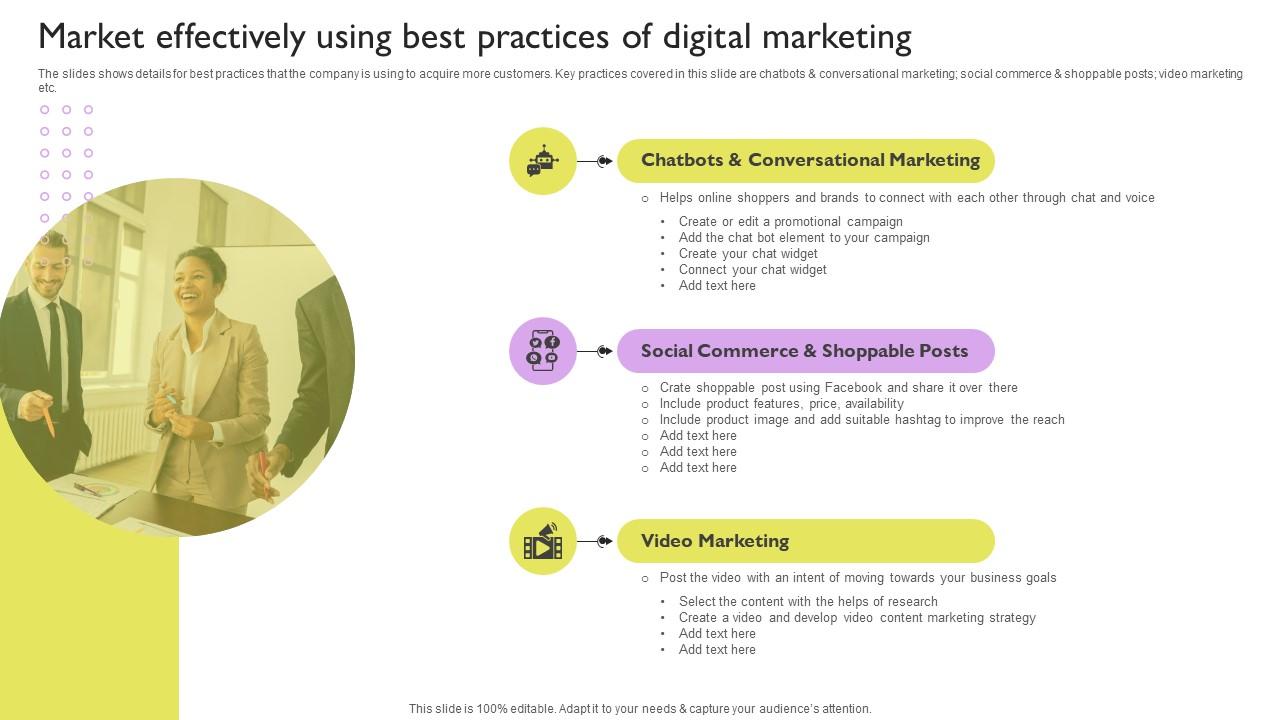How to Effectively Use Chatbots in Digital Marketing
Chatbots are changing digital marketing. They streamline tasks and enhance customer interactions.
But how can you use chatbots effectively in your marketing strategy? Chatbots can be powerful tools for any digital marketer. They can improve customer service, increase engagement, and even boost sales. Yet, many businesses struggle to use them correctly. This guide will show you how to harness the power of chatbots.
We’ll explore their benefits and offer tips for integrating them into your marketing plan. By understanding the best practices, you can make the most of this technology. Stay tuned to learn how chatbots can transform your digital marketing efforts.

Credit: www.marinsoftware.com
Table of Contents
Introduction To Chatbots
Chatbots have become a key player in the world of digital marketing. They help businesses interact with customers in real-time. This technology can boost customer engagement and improve user experience. But what are chatbots exactly? Let’s find out.
What Are Chatbots?
Chatbots are software programs designed to simulate human conversations. They use text or voice commands to interact with users. These bots can handle simple queries and provide instant responses. Some advanced chatbots use artificial intelligence. This allows them to learn from interactions and improve over time.
Importance In Digital Marketing
Chatbots are vital in digital marketing for several reasons. First, they offer 24/7 customer service. This means users can get help anytime, even outside business hours. Second, chatbots can handle multiple queries at once. This reduces the workload on human agents and speeds up response times. Third, chatbots can gather valuable data on customer preferences. This data helps businesses tailor their marketing strategies.
Using chatbots in digital marketing can also enhance user engagement. They provide immediate responses, which keeps users interested. Moreover, chatbots can guide users through the sales funnel. They can answer questions about products and services, making the buying process smoother. This can lead to higher conversion rates.

Credit: www.outbrain.com
Benefits Of Chatbots
Chatbots can boost digital marketing by offering immediate customer service and personalized interactions. They improve engagement and increase conversion rates efficiently.
The benefits of chatbots in digital marketing are vast and impactful. They can transform the way businesses interact with customers, providing seamless and efficient experiences. Let’s delve into some of the key benefits of using chatbots. ### Enhanced Customer Engagement Chatbots can significantly boost customer engagement. By offering instant responses, they keep visitors on your website longer. I remember visiting an e-commerce site late at night and the chatbot answered my queries instantly. This immediate interaction made me feel valued and led me to make a purchase. Chatbots can personalize conversations based on user data. They can suggest products, provide relevant information, and even remember past interactions. This personalization makes customers feel special and understood. ### 24/7 Availability One of the greatest advantages of chatbots is their round-the-clock availability. Imagine you’re browsing a website at 3 AM and need assistance. A chatbot can provide instant support, ensuring your needs are met regardless of time zones. This constant availability means you never miss a potential lead. Even when your human team is off-duty, chatbots can handle inquiries, schedule appointments, and gather customer information. This ensures your business is always operational and responsive. Have you ever wondered how many leads you might be missing due to unavailability? Implementing chatbots can solve this problem effectively. In conclusion, using chatbots in digital marketing can enhance customer engagement and ensure your business is always available to meet customer needs.Implementing Chatbots
Implementing chatbots in your digital marketing strategy can significantly boost customer engagement and streamline communication. However, the success of chatbots largely depends on how well you implement them. Let’s delve into the critical steps for effective chatbot implementation.
Choosing The Right Platform
Choosing the right platform is crucial for chatbot success. You need to consider where your audience spends most of their time. Is it on your website, Facebook Messenger, or WhatsApp?
Consider platforms like Tidio, Drift, or MobileMonkey. They offer user-friendly interfaces and integration options. Test different platforms to see which one best suits your needs.
Don’t forget to think about scalability. As your business grows, your chatbot should grow with it. Ensure your chosen platform can handle increased traffic and additional features.
Integrating With Existing Systems
Integrating chatbots with your existing systems ensures a seamless customer experience. Connect your chatbot to your CRM to keep track of customer interactions. This way, you can provide personalized responses based on past interactions.
Think about how the chatbot will handle orders and queries. Integration with your e-commerce system can automate order processing and provide real-time updates. This not only saves time but also enhances customer satisfaction.
Ensure the integration process is smooth. You may need to work with your IT team or platform support to ensure everything works perfectly. Test thoroughly to avoid any hiccups post-implementation.
Have you thought about how chatbots can reduce your workload? By integrating them effectively, you can focus more on strategic tasks while your chatbot handles routine queries. This could be a game-changer for your digital marketing strategy.

Credit: www.slideteam.net
Optimizing Chatbot Performance
Boost digital marketing by using chatbots effectively. Enhance customer engagement, personalize interactions, and provide instant support to improve user experience.
Optimizing Chatbot Performance Chatbots can revolutionize your digital marketing strategy, but they need continuous optimization to stay effective. Like any other tool, if you don’t fine-tune them, they can quickly become more of a hindrance than a help. Here’s how you can ensure your chatbots are always performing at their best.Analyzing User Data
Collect and study user data to understand how people interact with your chatbot. This data can reveal common questions and issues, helping you refine the bot’s responses. Use analytics tools to track these interactions. Look for patterns that indicate user satisfaction or frustration. For example, if users frequently drop off at a particular point, it’s a sign that something needs fixing there.Continuous Improvement
Your chatbot should evolve based on user feedback and data analysis. Make regular updates to address any identified weaknesses. Experiment with different approaches to see what works best. A/B testing can be invaluable here. Don’t be afraid to make changes. The digital landscape is always shifting, and your chatbot should be adaptable. Personal Experience I once managed a chatbot for an e-commerce store. Initially, it had a high drop-off rate. By analyzing user data, we discovered that the bot’s responses were too generic. We updated it to offer personalized product recommendations. The user engagement skyrocketed. Engaging the Readers Have you ever wondered how many potential customers you might be losing due to an ineffective chatbot? By keeping an eye on performance and making continuous improvements, you can turn your chatbot into a powerful marketing tool. What’s your experience with chatbots? Have you noticed areas where they could improve? Your insights could lead to better optimization strategies. — This approach not only makes the chatbot more efficient but also keeps your audience engaged and satisfied. By continuously analyzing data and making improvements, you ensure your chatbot remains a valuable asset in your digital marketing toolkit.Frequently Asked Questions
How Is Chatbot Used In Digital Marketing?
Chatbots in digital marketing engage customers, answer queries, and provide personalized recommendations, enhancing user experience and driving conversions.
What Are The 7 Steps To Create A Chatbot Strategy?
1. Define your goals. 2. Understand your audience. 3. Choose the right platform. 4. Design conversation flow. 5. Develop and integrate. 6. Test thoroughly. 7. Monitor and optimize.
How To Use Bots For Marketing?
Use bots for marketing by automating customer interactions, personalizing messages, and providing instant responses. Implement chatbots on websites, social media, and messaging apps. Analyze data from bot interactions to improve strategies.
How Do You Make An Effective Chatbot?
To create an effective chatbot, define clear goals, use natural language processing, ensure user-friendly design, provide quick responses, and constantly update the bot based on user feedback.
Conclusion
Chatbots can greatly enhance your digital marketing efforts. They offer instant responses. This improves customer satisfaction. Chatbots also help gather valuable data. This data can guide your marketing strategies. Implementing chatbots saves time and resources. They handle repetitive tasks efficiently.
For best results, integrate chatbots wisely. Ensure they align with your brand’s voice. Regularly update them based on feedback. This keeps your chatbot relevant and effective. Start using chatbots today. Boost your digital marketing success.

